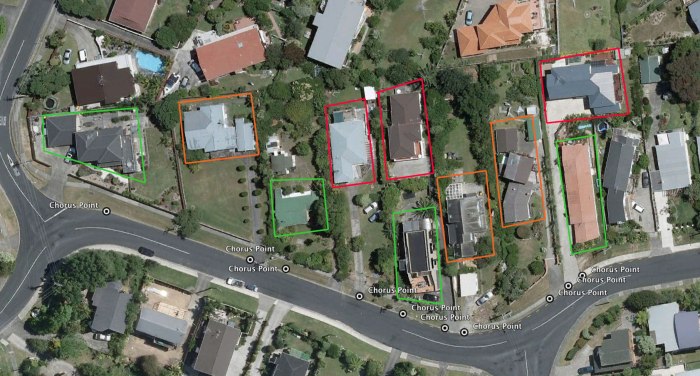On the 21st of May, the Commerce Commission published a draft report on their demand side study of high speed broadband. One of the more interesting bits has to do with the connection of houses to the Ultrafast Broadband (UFB) network.
Not All Contracts Are Equal
The sharp negotiators at Chorus managed to strike a last mile UFB deal with the Ministry of Economic Development that’s twice as good for suburban areas as the Local Fibre Companies Ultrafast Fibre, Enable, or Northpower received. This has implications for uptake, as retail Internet Service Providers marketing UFB products who will have a higher upfront cost for adding UFB subscribers to the Chorus network than they will for other networks.
How Are The Contracts Different?
The contract differences are in the “Installation Services” section of each contract, and have to do with how much fibre the providers will supply between their networks and subscriber houses, and how much fibre will be run inside each house. The table below shows the terms.
| Chorus | Enable | Northpower | UltraFast Fibre | |
| Aerial Drop Lead | Single Span | Double Span | Double Span | Double Span |
| Buried Lead-In | 15 Meters | 30 Meters | 30 Meters | 30 Meters |
| Inside Premises Wiring | 5 Meters | 10 Meters | 10 Meters | 10 Meters |
Aerial Drop Leads
Aerial Drop Leads are the spans of cable in an overhead network that connect a house to a utility pole. While the three smaller fibre providers are required to connect houses with up to two spans of cable, Chorus is only required to supply one span. Additional spans will attract an additional charge, to be advised on installation.
The photo below the illustration shows an example on Killarney Ave in Torbay, North Shore, and is one of many two-span installations on the street.
Buried Lead-Ins
Buried Lead-Ins are where the UFB provider digs from their roadside junction to the subscriber’s house. In the case of the smaller three UFB providers, they will dig and install up to 30 meters of underground cable. Chorus will only install fifteen.
While 15 meters may work well in new suburbs, it will be inadequate for half the houses in any urban housing area. The diagram below shows an example on Killarney Ave in Torbay, North Shore. Red boxed houses would attract a surcharge under either provider. Orange boxed houses would be covered free by the three smaller LFCs, but not by Chorus. Green boxed houses would be covered by all UFB providers. The “Chorus Points” here are an estimate, but any real world placement will be no closer to the houses in this example.
Inside Premises Wiring
When a UFB provider brings new fibre to a house, it enters the house at an “External Termination Point”. It’s not necessary for the fibre to be broken there, it could extend in to the house for termination. In the case of an installation done by the three smaller LFCs, this can be a ten meter span of fibre inside. In the case of Chorus, it’s a five meter span. Those meters are cable meters, not lateral meters. That means if a cable can’t be run along the floor, at least two meters are lost as soon as the cable enters the house.
The diagram of a State House below shows how in a typical Chorus installation, fibre can run out in the foyer, while in an installation done by one of the other LFCs the fibre can make it all the way to the center of a house.
The differences in potential costs for installation across regions and providers are likely to cause huge problems for retail Internet Service Providers. The lack of clarity on the process for determining excess charges for retail subscribers is also disappointing. It’s no wonder that almost a year in to the UFB build, not a single standard retail connection has been sold on the new Chorus UFB network.





One of the issues here that needs to be explored is around contractual obligations versus offers.
First, the links to three of the LFCs are to offer documents. Is it known what Telecom Chorus offered?
Second, I have not seen UFB contract documents signed with any LFC and so do not know how an offer translated to a contractual obligation. What I have seen is the CFH pricebook for Northpower and Enable.
What this pricebook discloses under Connection and MAC Charges is, “$0 for residential standard drops and 1xCCPM for non-residential standard drops4” (CCPM = “Customer Charges per Month”). A standard drop is not defined but it leaves open the issue of non-standard charges for residential customers. I recall a statement from Northpower that they would not be charging for non-standard residential connections and this seemed to be a voluntary action rather than a contractual requirement. Can anyone substantiate this?
The other issue is around the different treatment given to urban connections from rural ones. By definition, all rural connection to fibre are “non-standard”. In an egalitarian society this is government defined discrimination.
LikeLike
Hi John,
The contractual obligations are the same, as per “Attachment 1: Standard residential connections details” in the Commerce Commission report linked first.
I can’t comment on the pricebooks – I believe that information is confidential between LFCs and their retail partners.
-JB
LikeLike